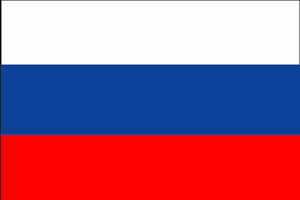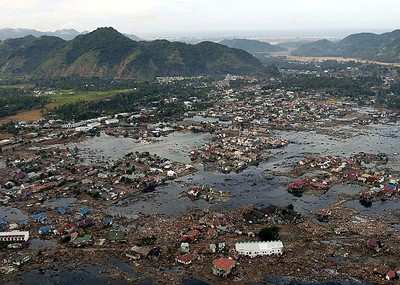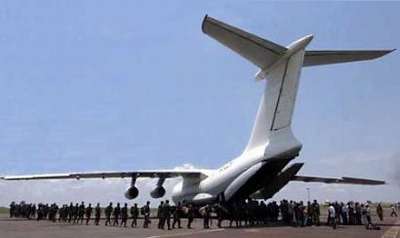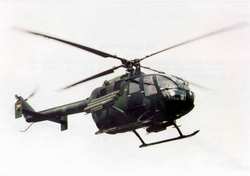Flies More Than 500 Tons Of Supplies To Tsunami Victims
 As of January 14th, Russia had flown
more than 500 tons of vital relief supplies to the disaster
stricken nations of South East Asia with the overall contribution
to the worldwide aid effort estimated at 22 million dollars.
As of January 14th, Russia had flown
more than 500 tons of vital relief supplies to the disaster
stricken nations of South East Asia with the overall contribution
to the worldwide aid effort estimated at 22 million dollars.
The Russian Federation immediately joined the global relief
operation to provide humanitarian aid to the countries affected by
the natural disaster in the Indian Ocean. From December 26, 2004 to
January 5, 2005, Russia deployed duty units from the national
humanitarian emergency response corps of the Russian Ministry of
Emergencies, men and equipment from the Russian Defense Ministry
and the Russian Reserve and other resources to provide the
necessary assistance in response to the received requests (the
first request for assistance was received from the government of
Sri Lanka at 11:30 on December 26, 2004).
In the early morning of December 27, 2004, two Emergency
Ministry IL-76 transports departed from Russia on the flight path
Moscow-Shardja-Colombo-Shardja-Moscow. The first plane delivered a
group of rescue workers, a search-and-rescue helicopter, special
transportation equipment and various supplies. The second plane
delivered tents and blankets to Sri Lanka.
During the first stage of the relief operation in Sri Lanka,
Russia focused on supporting the international coordination of the
emergency relief effort. Two representatives of the Russian
Emergencies Ministry joined the UN Group on Assessment and
Coordination (UNDAC), ensuring that rescue teams and humanitarian
cargo from various countries and organizations were received
appropriately at the airport in Colombo.
A Bo-105 Eurocopter, which arrived on board one of the IL-76s
and thanks to Global Radius technology could be prepared for action
in 30 minutes after delivery, proved very effective in rescue
operations, including those at the request of the UN Mission. It
conducted reconnaissance flights over areas of the island (up to
six kilometers inland) devastated by the tidal wave.

In cooperation with officials from the medical department of the
Kalutara district, Russian rescue workers immediately joined work
to provide medical aid to the local population. They helped 362
injured people, including 114 children aged from 1 month to 17
years, concentrating their efforts on the territory of a Buddhist
temple and a Catholic church, where people sought shelter after
losing their housing. Considering the complicated epidemic
situation, rescue workers had to take strict hygienic measures.
Search-and-rescue operations were focused on areas where the
transportation infrastructure and vehicles (roads, trains, and
sea-faring vessels) had been destroyed by the tsunami. Groups of
local volunteers worked effectively in relief operations under the
instruction of Russian experts.

During the initial stage of the relief operation, international
rescue teams encountered various problems, including a lack of
organization and communications, controversy over the order of
relief operations in various regions, and a lack of security. For
example, the subversive operations of separatists in the northern
regions stopped the relief effort of an Austrian rescue team.
Nevertheless, with the creation of the National Relief Management
Center under the President of Sri Lanka, the coordination of relief
effort improved significantly and the Russian rescue team was sent
to southern regions of the island (cities of Kalutara and Galle).
Representatives from headquarters of the local branch of the
Socialist Party and police were assigned to the Russian team to
ensure coordination and liaison.
On December 29, 2004, the third IL-76 with tents,
water-purifying systems and disinfectants was sent to Colombo.
On December 30, 2004, the fourth IL-76 flight, carrying three
tons of bottled drinking water desperately needed on the devastated
Thai coast, took off from Russia along the route
Yekaterinburg-Shardja-Phuket-Shardja-Moscow.
 On their return flights, the planes
carried 113 Russian and CIS citizens who had lost their documents
and personal possessions in the natural disaster in Thailand and
Sri Lanka, and needed medical assistance, including on the
flight.
On their return flights, the planes
carried 113 Russian and CIS citizens who had lost their documents
and personal possessions in the natural disaster in Thailand and
Sri Lanka, and needed medical assistance, including on the
flight.
On January 5-7, 2005, the fifth plane, an IL-76, flew to
Indonesia following the route Moscow-Shardja-Medan-Shardja-Moscow,
delivering tents, blankets, linen and electric power generators to
the island of Sumatra.
Starting from January 7, 2005, in accordance with instructions
of the Russian president on further increasing the Russian relief
effort to Southeast Asian countries devastated by the natural
disaster, the Russian government decided to supplement the efforts
of the Russian Emergencies Ministry with aviation and resources
from the Defense Ministry, the Russian Reserve, and the Health
Ministry. Moreover, the Russian Ministry of Agriculture sent grain
supplies to the region.
 NTSB Final Report: Cozy Cub
NTSB Final Report: Cozy Cub ANN FAQ: Contributing To Aero-TV
ANN FAQ: Contributing To Aero-TV Classic Aero-TV: Seated On The Edge Of Forever -- A PPC's Bird's Eye View
Classic Aero-TV: Seated On The Edge Of Forever -- A PPC's Bird's Eye View ANN's Daily Aero-Linx (04.29.25)
ANN's Daily Aero-Linx (04.29.25) ANN's Daily Aero-Term (04.29.25): Execute Missed Approach
ANN's Daily Aero-Term (04.29.25): Execute Missed Approach






